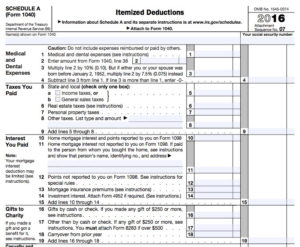Last time, we talked about the potential new tax rates. Much of my concern focussed on the standard deduction, which looks to rise quite a bit at the peril of personal exemptions. 
But, as I hinted, there are opportunities to shift things around to our advantage. Let’s look at Schedule A (you can click the image to view it regular size). It starts with medical deductions. When working, our insurance premiums were deducted pre-tax, so this line never really mattered much. Now, the full tab is our cost and it’s above 10% of our income, but it occurred to me – why lose that 10% every year? Say the insurance cost is $10,000, but only $5,000 can be deducted. By paying the full 2017 premium before the end of this year, the entire insurance bill can be added to the Schedule A. This results in $2500 saved tax for paying the 2017 insurance an average of 6 months early. Think on this, it’s not paying a year early, since the payments aren’t due next December, they are due each month. The return on that $10,000 is actually close to 50%.
The same strategy can be applied to property taxes. Even if the bill for the second half of next year hasn’t been issued yet, the town is probably happy to take your money early. Depending on the size and cost of your house, this can be $4,000-$10,000 (or more), in a deduction pulled into this year.
The third, and last, deduction I’ll mention is charitable contributions. Schwab, Vanguard, and Fidelity all offer a way to make your donation and deduct it this year, but disburse it to charities at a future time. This is a great way to consistently support your favorite charities, while maximizing your tax saving.
If the new tax code passes, and you had $25,000 or so in itemized deductions, this strategy might help you group your deductions so that the $50,000 2 year total is split to $45,000 in odd years and $5,000 in even years. In other words, you take the $30,000 standard deduction one year, but pull in all you can to take $45,000 the next year. That’s nearly a $4,000 benefit by juggling the timing a bit.
Keep in mind, I wrote this with my thoughts toward the new tax code, but this strategy can help people now. A couple who looks at their tax return and realizes they have just $12,000 in itemized deduction, vs the standard deduction of $12,600, can use this method of pulling in deductions from 2017. I know that I’ll be writing a check next week for our entire 2017 medical insurance premium.
Let me know if this strategy is something that can save you some money on your taxes. More year end tax thoughts coming.

I might not benefit personally right now, but my dad might benefit from a strategy like this one.
In my case, I’ll see the most benefit by paying my medical insurance ahead every other year. The more I study these issues the more I realize how convoluted our tax code is. Let me know if you talk to your dad about this.
My dad’s initial response was that he didn’t have the cash-flow to make it work since he needs money from his IRA to pay ahead, but he is trying to keep his withdrawals low, for obvious reasons. So I’ll probably end up helping him with the liquidity to pay his premiums in advance. Another place that he is going to look for tax savings is to see if there is a way to make some of his charitable contributions directly from his IRA to avoid it becoming income. We’ll see whether any loopholes of that sort survive the coming legislation.
I also wonder about mortgage interest–and particularly whether banks would allow prepayment of mortgage interest while still taking principal payments throughout the following year. It’s another strategy with no value to me personally, but it could help others I know.
Just saw this. (repeat commenters post moderation-free, so it doesn’t queue up)
I think it’s doable so long as you are clear to the bank, i.e. $2000 sent against a $1000 payment due with no note should result in a $1000 principal prepayment, which is wrong. You want to include the ‘payment coupons’, a whole bunch. This should do what you’re suggesting. But the return is far less depending how much time is left on the loan. Right now 1/4 of my payments are interest. So, $10000 sent early will add $2500 to my Schedule A and result in $625 lower tax bill. Not the same impact as medical premia or property tax.